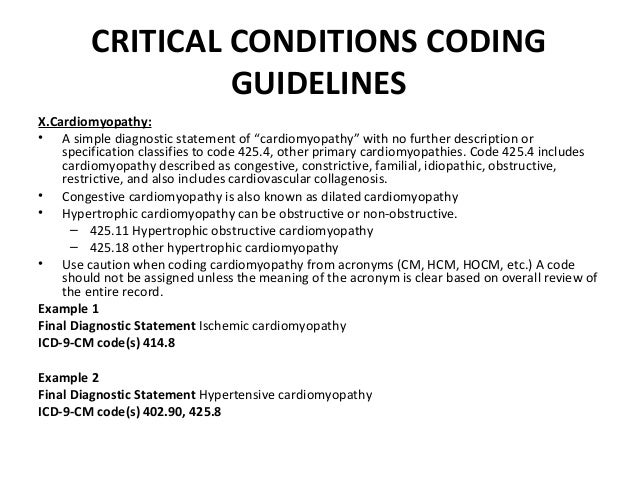

Centers for Medicare & Medicaid Services Risk Adjustment Data Validation (RADV) Medical Record Checklist and Guidance.2021 ICD-10-CM (Chapter 9: Diseases of the Circulatory System).Take advantage of the Annual Health Assessment (AHA) or other yearly preventive exam as an opportunity to capture all conditions impacting patient care.Note complications with an appropriate treatment plan.Document each diagnosis as having been monitored, evaluated, assessed and/or treated on the date of service.

 Ensure documents are signed and dated by a credentialed provider. Document legibly, clearly and concisely. Include patient demographics, such as name and date of birth, and date of service in all progress notes. The type of AF (paroxysmal, persistent, permanent or history of) should be documented consistently throughout the note to avoid unspecified codes that don’t fully define the member’s condition. Only one code may be assigned for a specific type of AF. Document in the note any current associated physical exam findings (such as irregular heart rhythm or increased heart rate) and related diagnostic testing results. In coding, history of indicates a condition is no longer active. Code I48.19, Other persistent atrial fibrillation, should be assigned. Chronic persistent AF has no widely accepted clinical definition or meaning. Chronic AF, unspecified (I48.20) may refer to any persistent, longstanding persistent or permanent AF. Permanent AF (I48.21) is persistent or longstanding persistent AF where cardioversion cannot or will not be performed, or is not indicated. Persistent AF (I48.11) describes AF that does not terminate within seven days, or that requires repeat pharmacological or electrical cardioversion. ICD-10-CM AF CodesĪccording to ICD-10-CM guidelines, these four unique codes describe the types of AF: This information is from the ICD-10-CM Official Guidelines for Coding and Reporting and the resources listed below. Below are resources for coding and documenting atrial fibrillation (AF). High quality documentation and complete, accurate coding may help capture our members’ health status and promote continuity of care. Let us know what you think by emailing our editorial staff.
Ensure documents are signed and dated by a credentialed provider. Document legibly, clearly and concisely. Include patient demographics, such as name and date of birth, and date of service in all progress notes. The type of AF (paroxysmal, persistent, permanent or history of) should be documented consistently throughout the note to avoid unspecified codes that don’t fully define the member’s condition. Only one code may be assigned for a specific type of AF. Document in the note any current associated physical exam findings (such as irregular heart rhythm or increased heart rate) and related diagnostic testing results. In coding, history of indicates a condition is no longer active. Code I48.19, Other persistent atrial fibrillation, should be assigned. Chronic persistent AF has no widely accepted clinical definition or meaning. Chronic AF, unspecified (I48.20) may refer to any persistent, longstanding persistent or permanent AF. Permanent AF (I48.21) is persistent or longstanding persistent AF where cardioversion cannot or will not be performed, or is not indicated. Persistent AF (I48.11) describes AF that does not terminate within seven days, or that requires repeat pharmacological or electrical cardioversion. ICD-10-CM AF CodesĪccording to ICD-10-CM guidelines, these four unique codes describe the types of AF: This information is from the ICD-10-CM Official Guidelines for Coding and Reporting and the resources listed below. Below are resources for coding and documenting atrial fibrillation (AF). High quality documentation and complete, accurate coding may help capture our members’ health status and promote continuity of care. Let us know what you think by emailing our editorial staff. #ICD 10 CODE FOR ATRIAL FLUTTER SERIES#
Additional articles in the series will run throughout the year. This month we are featuring documentation and coding information on atrial fibrillation and diabetes mellitus. In response, our Coding Compliance department has identified resources to help providers accurately code and document patient conditions. In our annual Blue Review readership survey, many of you asked for more articles on coding. Here, you will find cardiology ICD 10 codes related to myriad disease states and diagnoses-chest pain ICD 10 codes, the hypokalemia ICD 10 classification, several hyperlipidemia ICD 10 codes, numerous diabetes ICD 10 codes, sepsis ICD 10 for unspecified organisms, and various cardiology ICD 10 pain codes.February 2021 Documentation and Coding Series: Atrial Fibrillation This table has been curated for use by cardiology specialists to include cardiology ICD 10 codes and classifications relevant to cardiovascular conditions. This is a comprehensive table of cardiology ICD 10 codes used by researchers as well as healthcare professionals and personnel-nurses, medical coders, physicians, et al.







 0 kommentar(er)
0 kommentar(er)
